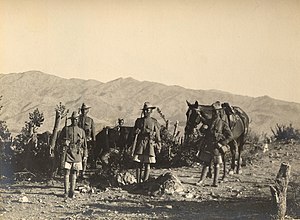Waziristan campaign 1919–1920
| Waziristan campaign 1919–20 | |||||||
|---|---|---|---|---|---|---|---|
 2nd/5th Royal Gurkha Rifles, who were stationed in the North-West Frontier following the 1919–20 campaign |
|||||||
|
|||||||
| Belligerents | |||||||
|
|
|||||||
| Commanders and leaders | |||||||
| ? |
Skipton Climo Andrew Skeen |
||||||
| Strength | |||||||
| Tochi Wazirs: ~13,500 Wana Wazirs: ~11,900 Mahsuds: ~10,900 |
4 Brigades 1 Air Force Wing |
||||||
| Casualties and losses | |||||||
| Several thousand | ~2,286 | ||||||
The Waziristan campaign 1919–20 was a military campaign conducted in Waziristan by British and Indian forces against the fiercely independent tribesmen that inhabited this region. These operations were conducted in 1919–20, following the unrest that arose in the aftermath of the Third Anglo-Afghan War.
The prelude to the 1919–20 campaign was an incursion by the Mahsud Tribe in the summer of 1917 while British forces were otherwise engaged fighting in the First World War. The British Forces eventually restored calm, however, in 1919 the Waziris took advantage of unrest in Afghanistan following the Third Anglo-Afghan War to launch more raids against British garrisons. It has been asserted that one of the reasons for these raids was that a rumour had been spread amongst the Wazirs and the Mahsuds, that Britain was going to give control of Waziristan to Afghanistan as part of the peace settlement following the Third Anglo-Afghan War. Buoyed by this prospect and sensing British weakness, the tribes were encouraged to launch a series of large scale raids in the administered areas. By November 1919, they had killed over 200 people and wounded a further 200.
The first attempt to subdue them began in November 1919, when Major-General Sir Andrew Skeen launched a series of operations against the Tochi Wazirs. These operations were largely successful and terms were agreed, and in December Skeen turned his attention to the Mahsuds. As the 43rd and 67th Brigades were grouped together as the Derajet Column and committed to the fighting, they met heavy resistance as the largely inexperienced Indian units came up against determined, well-armed tribesmen. Due to the denuding of the Indian Army caused by commitments overseas during the First World War, many of the battalions employed in this campaign were second-line units with disproportionately large numbers of very young soldiers with inexperienced officers.
...
Wikipedia
